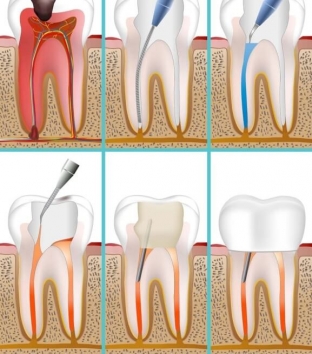Inflammation of the periodontium may be accompanied by proliferative processes, in which bone tissue is resorbed and granulations grow at the top of the tooth root. This periodontal disease is called granulating periodontitis. In dental practice, such periodontitis ranks third in frequency of occurrence after pulpitis and caries. Chronic periodontitis in most cases is a complication of caries, and granulating periodontitis, in turn, is the main cause of tooth extraction.
Causes and mechanism of development of granulating periodontitis
Chronic granulating periodontitis develops when an infection enters through the apical opening of the root canal. This happens due to complications of deep caries or pulpitis. It is possible to develop granulating periodontitis against the background of apical periodontitis or tooth trauma.
Granulation process in the periodontium can develop after frequent and aggressive exposure to drugs in the treatment of dental canals. Poor oral hygiene and the accumulation of plaque contribute to the development of granulating periodontitis.
Against the background of inflammatory infiltration in granulation periodontitis, granulation tissue grows in the near-apex region, in which there are areas of calcification (petrificates and denticles). This process is accompanied by cell death – odontoblasts, destruction of the periosteum and compact bone substance, as well as resorption of bone walls. When the infection spreads to soft tissues, perimaxillary abscesses form.
Clinical manifestations and possible complications of granulating periodontitis
The course of chronic granulating periodontitis is characterized by constant exacerbations, which are replaced by short remissions. With an exacerbation of granulating periodontitis, the patient feels pain in the affected tooth. What can worsen the patient's condition, read more on estet-portal.com. Toothache appears paroxysmal in response to thermal or mechanical stimuli. Objectively, the gums are pasty, swollen and hyperemic. There is a slight mobility of the tooth, a painful infiltrate is palpated in the projection of the root. On the side of the affected tooth, there is an increase and soreness of the lymph nodes.
At the peak of exacerbation of granulating periodontitis, a fistula is formed at the site of the infiltrate, from which purulent or serous contents are released. Granulation tissue grows around the mouth of the fistula. It is important to know that the fistulous tract may open on the neck or on the face, while the clinical picture is similar to signs of subcutaneous actinomycosis.
After the outflow of purulent exudate, the pain subsides, and granulating periodontitis passes into a chronic asymptomatic course. During the period of remission, pain may occur when eating hot food.
Granulating periodontitis can be complicated by the following pathologies:
- jaw cyst;
- dental granuloma;
- cellulitis or abscess of surrounding soft tissues;
- odontogenic sinusitis;
- sepsis.
Diagnosis and treatment of granulating periodontitis
 During examination, the dentist reveals a heavily damaged tooth that has been changed in color, the carious cavity communicates with the tooth cavity. Percussion is painful, when pressed with a probe, the gums turn pale sharply. With the help of electroodontodiagnostics, the excitability of the pulp is determined. X-ray allows you to determine the degree of tooth decay.
During examination, the dentist reveals a heavily damaged tooth that has been changed in color, the carious cavity communicates with the tooth cavity. Percussion is painful, when pressed with a probe, the gums turn pale sharply. With the help of electroodontodiagnostics, the excitability of the pulp is determined. X-ray allows you to determine the degree of tooth decay.
The modern approach to the treatment of granulating periodontitis consists in tooth-preserving methods of treatment. The treatment is carried out in several sessions, as a result of which a permanent filling is placed. If necessary, remove the granulation tissue. If the treatment of granulating periodontitis is ineffective, the tooth is extracted.









Add a comment